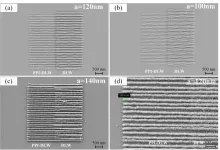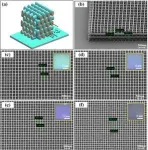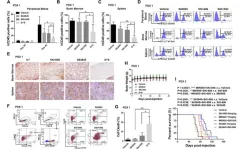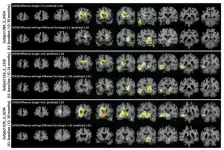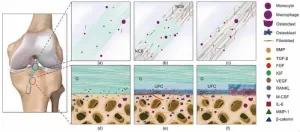(Press-News.org) WASHINGTON — For the first time, researchers have used high-speed laser writing to create lines spaced just 100 nm apart on a glass substrate. The optimized printing approach could enable super-resolution 3D direct laser writing (DLW) of microlenses, photonics crystals, micro-optical devices, metamaterials and more.
DLW is an additive manufacturing technique that uses a focused laser beam to selectively solidify, or polymerize, a material with nanoscale precision. DLW typically uses multi-photon polymerization to polymerize materials in a precise, 3D manner.
“Increasing the resolution — the minimum distance between two adjacent features — is difficult because the intense laser light can cause unwanted exposure in nearby areas during DLW,” said Qiulan Liu, a member of the research team from Zhejiang Lab and Zhejiang University in China. “However, by using a unique dual-beam optical setup and a special photoresist, we were able to overcome this challenge and achieve super-resolution DLW."
In the Optica Publishing Group journal Optics Letters, the researchers describe their new approach and show that the record-breaking 100-nm lateral resolution can be achieved at 100 µm/s printing speeds. When an even faster writing speed of 1000 μm/s is used, a 120-nm lateral resolution could still be achieved.
“One exciting application of our DLW technique is printing optical waveguide devices for virtual reality or augmented reality displays with precise, high-resolution structuring,” said Liu. “This fast and high-precision approach allows rapid fabrication of complex optical elements, which are crucial for the performance of next-generation immersive technologies.”
Reducing crosslinking
In the new work, the researchers performed experiments using both multiphoton DLW and DLW with peripheral photoinhibition, which uses an inhibition beam to suppress polymerization at the edges of the laser-exposed region.
They developed a photoresist system that consisted of a commonly used monomer known as PETA combined with Bis(2,2,6,6-tetramethyl-4-piperidyl-1-oxyl) sebacate (BTPOS). BTPOS acted as a radical quencher that helped reduce the crosslinking that can occur when using DLW to print high-resolution line patterns.
The optical setup included a 525-nm femtosecond laser as the excitation light source and a 532-nm picosecond laser used for inhibition. The femtosecond laser triggers the picosecond laser through a picosecond delay unit, which introduces a 2700 ps delay due to the difference in the optical paths of the two beams. The inhibition beam prevents unwanted polymerization and ensures that the desired pattern is formed with high resolution and precision.
“To achieve high resolution, we also used a spatial light modulator (SLM) to modulate the excitation and inhibition light, and applied Zernike polynomials onto the SLM to correct wavefront aberrations,” said Liu. “We also had to make sure the entire system was very stable, taking into account laser focus alignment, laser power fluctuation, the optical system drift, and memory effect, which stems from the excitation and inhibition beams.”
Printing tiny structures
The researchers performed several experiments demonstrating the speed and resolution of their optimized DLW approach. They also fabricated tiny 3D woodpiles with lateral rod spacing from 300 nm to 225 nm. The smallest axial period between the wood layers was 318 nm, which reaches the diffraction-limited axial resolution of 320 nm. This diffraction limit is determined by the laser wavelength and the optical system's ability to focus the laser beam.
The researchers are now working to further improve the writing speed, with a goal of reaching speeds of 10 and 100 mm/s while maintaining high writing quality and resolution. They also want to improve the photoresist system to make the DLW technique more stable and practical.
Paper: X. Liu, Q. Liu, M. Luo, L. Xu, C. Kuang, X. Liu, “Super-resolution direct laser writing via multiphoton and peripheral photoinhibition photolithography,” Opt. Lett., 50, 1675-1678 (2025).
DOI: https://doi.org/10.1364/OL.552034
About Optica Publishing Group
Optica Publishing Group is a division of the society, Optica, Advancing Optics and Photonics Worldwide. It publishes the largest collection of peer-reviewed and most-cited content in optics and photonics, including 18 prestigious journals, the society’s flagship member magazine, and papers and videos from more than 835 conferences. With over 400,000 journal articles, conference papers and videos to search, discover and access, our publications portfolio represents the full range of research in the field from around the globe.
About Optics Letters
Optics Letters has been publishing high-impact research in the field of photonics for over 45 years and offers rapid dissemination of new results in all areas of optical science with short, original, peer-reviewed communications. Optics Letters accepts papers that are noteworthy to a substantial part of the optics community. Published by Optica Publishing Group and led by Editor-in-Chief Miguel Alonso, Institut Fresnel, École Centrale de Marseille and Aix-Marseille Université, France, University of Rochester, USA. For more information, visit Optics Letters.
Media Contact
mediarelations@optica.org
END
Researchers demonstrate laser writing with unprecedented speed and resolution
Optimized approach enables super-resolution 3D direct laser writing for fabricating precision micro-optical devices and metamaterials
2025-02-27
ELSE PRESS RELEASES FROM THIS DATE:
New combination treatment strategy dramatically increases cell death in leukemia
2025-02-27
Scientists at VCU Massey Comprehensive Cancer Center have identified an innovative combination of treatment strategies that work collaboratively to effectively kill acute myeloid leukemia (AML) cells, a frequently incurable form of cancer.
New research findings — published in the Nature family journal Signal Transduction and Targeted Therapy — suggest that a class of drugs known as MCL-1 (myeloid leukemia cell-1) inhibitors interact with a type of kinase inhibitor that targets the SRC gene to efficiently trigger cell death in AML cells.
“Results from this research could add another approach ...
Patients with depression from wealthier areas more likely to use telehealth for mental health care
2025-02-27
A new study led by researchers at the Johns Hopkins Bloomberg School of Public Health found that mental health visits for patients with depression from high-wealth neighborhoods in Maryland were significantly more likely to happen via telehealth compared to patients with depression from low-wealth neighborhoods in Maryland from mid-2021 through mid-2024.
Telehealth visits by phone or web-based teleconferencing became popular during the COVID-19 pandemic after in-person health care options were scaled back and telehealth restrictions relaxed. The researchers investigated how mental health care visits changed from before and over the course ...
A versatile AI system for analyzing series of medical images
2025-02-27
A new AI-based system for analyzing images taken over time can accurately detect changes and predict outcomes, according to a study led by investigators at Weill Cornell Medicine, Cornell’s Ithaca campus and Cornell Tech. The system’s sensitivity and flexibility could make it useful across a wide range of medical and scientific applications.
The new system, termed LILAC (Learning-based Inference of Longitudinal imAge Changes), is based on an AI approach called machine learning. In the study, which appears Feb. 20 in the Proceedings of the National Academy of Sciences, the researchers developed the system and demonstrated it on diverse time-series of images—also ...
Breakthrough study discovers genetic mutation could be basis for novel treatment of rheumatoid arthritis
2025-02-27
TORONTO, Feb. 27, 2025 – Research led by York University’s Faculty of Health reveals how a specific mutation in a protein called TRAF1 can shut down an overactive immune response, dramatically reducing inflammation in mice. Lead researcher Ali Abdul-Sater says this discovery could pave the way for a new class of drugs to treat rheumatoid arthritis.
“Rheumatoid arthritis is a common health condition which can interfere with many aspects of daily life and based on the limited efficacy ...
Texas-France space hub aims to innovate space commerce and research
2025-02-27
A new trans-Atlantic space initiative has launched, linking Texas and France in an ambitious effort to fuel startup growth, drive research and forge international partnerships. Announced at the 2025 ASCENDxTexas event Feb. 27, the Texas-France Space Hub aims to unite academic institutions and private enterprises, expanding commercial space presence in both countries.
The three-year initiative fosters global partnerships in aerospace, bringing together Rice University, Stellar Access and Houston Spaceport in Texas with France’s space agency CNES and ...
Young star clusters give birth to rogue planetary-mass objects
2025-02-27
Planetary-mass objects (PMOs) are cosmic nomads: they drift freely through space, unbound to any star, and weigh less than 13 times the mass of Jupiter. While they have been spotted in abundance in young star clusters such as the Trapezium Cluster in Orion (Fig. 1), their origin has puzzled scientists. Traditional theories have suggested that they might be failed stars or planets ejected from their solar systems.
An international team of astronomers, in collaboration with the University of Zurich (UZH), has used advanced simulations to demonstrate that these enigmatic objects can form directly from the violent interactions of disks around young stars. “PMOs don’t ...
Scientists track pneumonia-causing bacteria as they infect the blood stream
2025-02-27
Bacteremia, or blood poisoning, occurs when bacteria overcome the body’s immune defenses.
Bacteremia can worsen into sepsis, a condition that accounts for more than 1 in 3 hospital deaths per year.
Yet people are routinely exposed to and fight off bacteria from the environment without this deadly series of events occurring.
Scientists are trying to figure out exactly how bacteria spread throughout the body to cause systemic infection in the hopes of eventually stopping this process in its tracks.
Michael Bachman, M.D., Ph.D., clinical associate professor of pathology and microbiology and immunology at U-M Medical School and former postdoc Caitlyn Holmes, Ph.D., ...
Nominations sought for 2026 Watanabe Prize in Translational Research
2025-02-27
The Indiana University School of Medicine is accepting nominations until May 15, 2025, for the 2026 August M. Watanabe Prize in Translational Research.
The Watanabe Prize is one of the nation’s largest and most prestigious research awards recognizing senior investigators focused on shepherding scientific discoveries into new therapies for patients. Nominees should be members of the scientific or medical communities who have demonstrated outstanding accomplishments in translational research.
The winner of the 2026 Watanabe Prize in Translational Research will receive a $100,000 award and spend time in Indianapolis from September 16-18, ...
Study finds support for solar energy has become politically polarized
2025-02-27
A new analysis of social media posts finds public support for solar energy remains high, though that support declined significantly from 2016 to 2022. The study also found solar power has become an increasingly polarized issue, with the shift in support being driven largely by opposition to solar power among people in regions that lean Republican.
“The U.S. saw significant growth in the solar energy sector between 2013 and 2022, but that growth has not been spread evenly across the country – some areas have seen more deployment of solar energy technologies than other areas,” says Serena Kim, corresponding author of ...
Advancements in artificial ligaments for ACL reconstruction: A leap towards improved outcomes
2025-02-27
Anterior cruciate ligament (ACL) injuries are common, especially among athletes. Each year, over 400 000 ACL reconstruction (ACLR) surgeries are carried out globally. While the success rate of ACLR is reported to be over 90%, a significant number of patients still face issues like revision surgery and long-term osteoarthritis. This has spurred research into better graft materials, and artificial ligaments have emerged as a potential solution. A recent review article published in Engineering delves into the current state and future prospects of artificial ligaments for ACLR.
Artificial ...
LAST 30 PRESS RELEASES:
Making lighter work of calculating fluid and heat flow
Normalizing blood sugar can halve heart attack risk
Lowering blood sugar cuts heart attack risk in people with prediabetes
Study links genetic variants to risk of blinding eye disease in premature infants
Non-opioid ‘pain sponge’ therapy halts cartilage degeneration and relieves chronic pain
AI can pick up cultural values by mimicking how kids learn
China’s ecological redlines offer fast track to 30 x 30 global conservation goal
Invisible indoor threats: emerging household contaminants and their growing risks to human health
Adding antibody treatment to chemo boosts outcomes for children with rare cancer
Germline pathogenic variants among women without a history of breast cancer
Tanning beds triple melanoma risk, potentially causing broad DNA damage
Unique bond identified as key to viral infection speed
Indoor tanning makes youthful skin much older on a genetic level
Mouse model sheds new light on the causes and potential solutions to human GI problems linked to muscular dystrophy
The Journal of Nuclear Medicine ahead-of-print tip sheet: December 12, 2025
Smarter tools for peering into the microscopic world
Applications open for funding to conduct research in the Kinsey Institute archives
Global measure underestimates the severity of food insecurity
Child survivors of critical illness are missing out on timely follow up care
Risk-based vs annual breast cancer screening / the WISDOM randomized clinical trial
University of Toronto launches Electric Vehicle Innovation Ontario to accelerate advanced EV technologies and build Canada’s innovation advantage
Early relapse predicts poor outcomes in aggressive blood cancer
American College of Lifestyle Medicine applauds two CMS models aligned with lifestyle medicine practice and reimbursement
Clinical trial finds cannabis use not a barrier to quitting nicotine vaping
Supplemental nutrition assistance program policies and food insecurity
Switching immune cells to “night mode” could limit damage after a heart attack, study suggests
URI-based Global RIghts Project report spotlights continued troubling trends in worldwide inhumane treatment
Neutrophils are less aggressive at night, explaining why nighttime heart attacks cause less damage than daytime events
Menopausal hormone therapy may not pose breast cancer risk for women with BRCA mutations
Mobile health tool may improve quality of life for adolescent and young adult breast cancer survivors
[Press-News.org] Researchers demonstrate laser writing with unprecedented speed and resolutionOptimized approach enables super-resolution 3D direct laser writing for fabricating precision micro-optical devices and metamaterials
